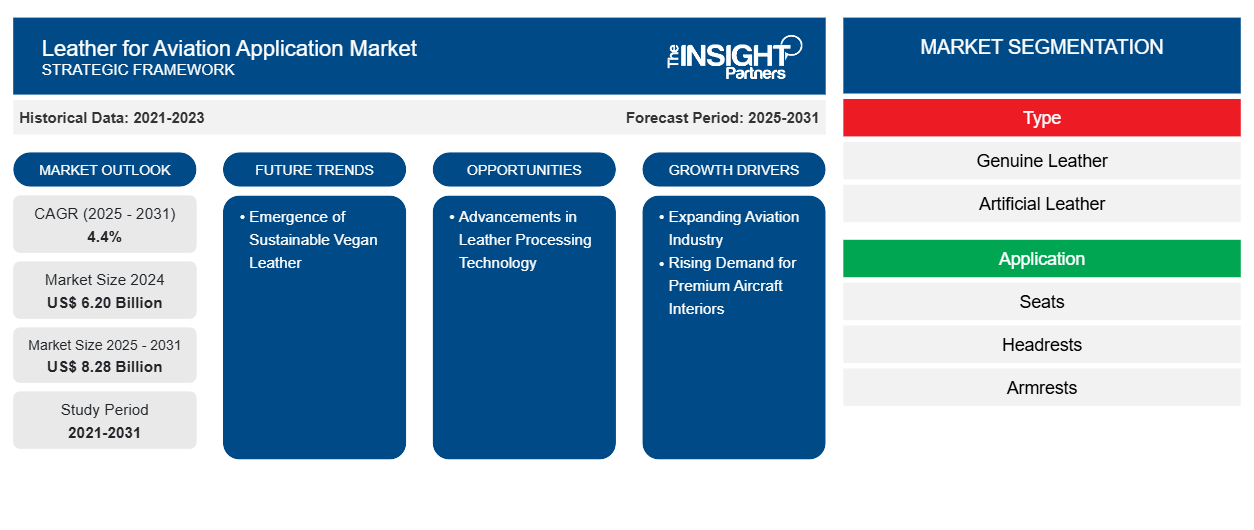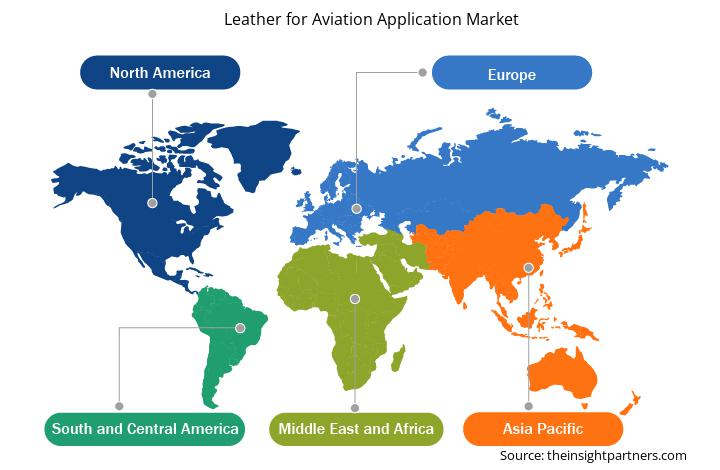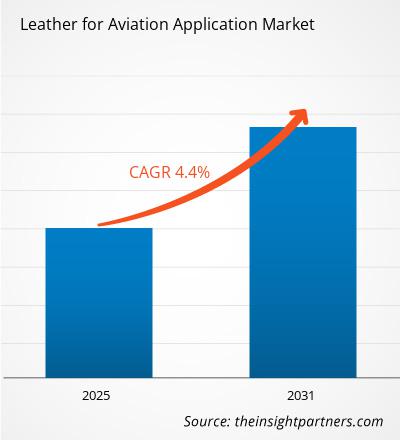预计到2031年,航空应用皮革市场规模将从2024年的62亿美元增至82.8亿美元。预计2025年至2031年期间,该市场的复合年增长率将达到4.4%。在预测期内,纯素皮革的日益普及预计将在航空应用皮革市场掀起一股新潮流。
航空应用皮革市场分析
航空业和旅游业的扩张、空中交通的不断增长以及对高端飞机内饰需求的不断增长,是推动全球航空皮革需求增长的主要因素。对高性能材料和航空旅行美感的需求日益增长,也推动了市场的发展。皮革加工技术的进步以及3D打印和生物打印等先进技术在皮革制造中的应用,预计将在预测期内为市场创造丰厚的利润。此外,研发活动的蓬勃发展、人们对使用环保材料益处的认识不断提高,以及可持续纯素皮革的不断发展,预计将为市场创造丰厚的利润。
航空应用皮革市场概览
皮革是一种由鞣制动物皮制成的坚固而柔韧的材料。由于其兼具强度、舒适性和美观性,皮革在航空业中被广泛应用。皮革通常用于飞机座椅、操纵杆或控制轮套、内饰以及豪华客舱装饰。其卓越的耐磨性使其成为航空应用的理想材料。此外,皮革比合成材料具有更高的隔热性和舒适性,能够提升乘客的旅行体验,尤其是在长途飞行中。皮革的奢华外观和质感也提升了商务舱和头等舱的高端形象。皮革易于清洁和保养,能够保持卫生并营造赏心悦目的客舱氛围,这使得其在飞机座椅和其他内饰部件的设计中更加实用。此外,现代航空级阻燃皮革的研发和严格的安全标准也促进了其在航空业的广泛应用。
您可以免费定制任何报告,包括本报告的部分内容、国家级分析、Excel 数据包,以及为初创企业和大学提供优惠和折扣
航空应用皮革市场:战略洞察

- 获取此报告的顶级关键市场趋势。此免费样品将包括数据分析,从市场趋势到估计和预测。
航空应用皮革的市场驱动力和机遇
高端飞机内饰需求不断增长
消费者对奢华舒适与高端美学的旅行体验日益增长的需求,促使航空业企业采用皮革来提升客户体验。众多飞机制造商更加注重座椅的美观,尤其是在商务舱和头等舱,以满足客户需求。如今,乘客越来越期待功能性与设计感的完美融合。皮革不仅美观耐用,更易于保养,因此成为座椅和内饰的首选材料。全球各地的飞机制造商正在将皮革应用于高端飞机内饰的开发,以满足乘客的需求。例如,达美航空于2024年10月宣布,将通过全新面貌提升客舱内饰,从而提升乘客体验。达美航空计划重新设计客舱内饰,包括采用织物和材料、在整个机舱内安装情绪照明,并在部分客舱内安装记忆海绵坐垫。此次重新设计确保达美优悦经济舱和主舱的乘客能够享受到采用全新色调和红色条纹的人造皮革座椅。宽体航班上的 Delta Comfort+ 和主舱座椅现在将配备记忆泡沫垫。
2024 年 12 月,拉塔姆航空宣布计划使用可持续再生皮革翻新其机队中 24 架飞机的座椅,总计 6,910 个座位。这一举措代表了该航空公司更广泛的客舱更新计划的一项战略进步,特别针对部署在国际航线上的飞机。作为其在南美维持现代高效机队的持续战略的一部分,该公司位于圣卡洛斯 (SP) 的最大维护中心 LATAM MRO 于 2024 年 9 月实施了部分变革。此外,长途国际旅行的兴起和富裕旅行者数量的增加正在推高对私人飞机和豪华商用飞机的需求。这增加了制造商对皮革的采用,以满足乘客的审美需求。此外,对客舱翻新和改造的投资不断增加,例如将座椅材料更换为优质皮革,正在推动市场发展。
皮革加工技术的进步
皮革因其持久的魅力和高品质而备受推崇,这推动了航空业对满足乘客审美和舒适度需求的需求。如今,皮革行业正利用现代尖端技术来保持皮革的品质、吸引力和负责任的生产方式。随着消费者环保意识的增强,以及制造商注重减少对环境的影响,对先进皮革生产工艺的需求也日益增长。皮革制造商正致力于开发先进的皮革加工技术,通过简化生产流程来打造独特的纹理和图案。例如,Muirhead 于 2024 年 5 月推出了一款采用无阻燃 (FR) 技术的全新 FreeTAN,帮助皮革制造商在所有生产过程中消除化石燃料、石油基元素和重金属的使用。此外,这些进步使皮革生产商能够优化生产流程,设计出可定制、性能卓越的纺织品,以满足航空业的严格要求,同时确保美观和舒适。
此外,智能技术与自动化监控系统等尖端技术的融合,使皮革制造商能够保持高效、质量控制和一致性。这些技术有助于皮革制造商减少生产时间、减少浪费,从而实现环保生产。因此,皮革制造工艺中日益增长的研发活动和技术进步正在为市场创造丰厚的利润。
航空应用皮革市场报告细分分析
有助于得出航空应用皮革市场分析的关键部分是类型、应用和飞机类型。
- 按类型划分,市场分为真皮和人造革。2024年,真皮占据了最大的市场份额。
- 根据应用,市场细分为座椅、头枕、扶手、坐垫、客舱内饰等。2024年,座椅领域占据航空皮革应用市场的最大份额。
- 根据飞机类型,市场分为私人飞机、商用飞机、军用飞机和其他飞机。商用飞机在2024年占据了最大的市场份额。
航空应用皮革市场份额地域分析
航空应用皮革市场报告的地理范围分为五个区域:北美、亚太、欧洲、中东和非洲以及南美和中美。预计欧洲航空应用皮革市场在预测期内将大幅增长。
欧洲航空皮革市场细分为法国、德国、意大利、西班牙、俄罗斯、英国和欧洲其他地区。2024年,欧洲航空业共计航班1070万架次,较2023年增长5%。这一增长表明,新冠疫情过后,欧洲航空业呈现了更广泛的复苏趋势,2019年欧洲航班量已恢复至疫情前水平的96%。夏季复苏尤为明显,表明旅行需求强劲复苏。最大的细分市场——“干线”和“低成本”航空公司——的市场份额均有所扩大,其中低成本航空公司增长了8%,干线航空公司增长了7%。随着航空公司力求在竞争激烈的市场中脱颖而出,使用高品质皮革成为提升整体乘客体验的关键因素。低成本航空公司的蓬勃发展以及其对升级客舱内饰的投资不断增加,进一步扩大了对皮革应用的需求。空中交通的上升趋势将对航空皮革市场产生重大影响。
航空应用皮革市场区域洞察
Insight Partners 的分析师已详尽阐述了预测期内影响航空应用皮革市场的区域趋势和因素。本节还讨论了北美、欧洲、亚太地区、中东和非洲以及南美和中美洲的航空应用皮革市场细分和地域分布。

- 获取航空应用皮革市场的区域特定数据
航空应用皮革市场报告范围
| 报告属性 | 细节 |
|---|---|
| 2024年的市场规模 | 62亿美元 |
| 2031年的市场规模 | 82.8亿美元 |
| 全球复合年增长率(2025-2031) | 4.4% |
| 史料 | 2021-2023 |
| 预测期 | 2025-2031 |
| 涵盖的领域 | 按类型
|
| 覆盖地区和国家 | 北美
|
| 市场领导者和主要公司简介 |
|
航空应用皮革市场参与者密度:了解其对业务动态的影响
航空应用皮革市场正在快速增长,这得益于终端用户需求的不断增长,而这些需求的驱动因素包括消费者偏好的不断变化、技术进步以及对产品优势的认知度不断提高。随着需求的增长,企业正在扩展产品线,不断创新以满足消费者需求,并抓住新兴趋势,从而进一步推动市场增长。
市场参与者密度是指特定市场或行业内企业或公司的分布情况。它表明特定市场空间内竞争对手(市场参与者)的数量相对于其规模或总市值而言。
在航空应用皮革市场运营的主要公司有:
- 三芳化学工业股份有限公司
- 富威尔有限公司
- 巴斯夫
- 帝人株式会社
- 东丽工业公司
- 科思创股份公司
免责声明:以上列出的公司没有按照任何特定顺序排列。

- 获取航空应用皮革市场顶级关键参与者概览
航空应用皮革市场新闻和最新发展
航空应用皮革市场的评估是通过收集一手和二手资料后进行的定性和定量数据进行的,这些数据包括重要的企业出版物、协会数据和数据库。航空应用皮革市场的一些关键发展如下:
- 巴斯夫欧洲公司单体部与异氰酸酯价值链重要合作伙伴旭川化工举行仪式,庆祝双方在合成革应用领域就生物质平衡(BMB)二苯基甲烷二异氰酸酯(MDI)达成战略合作。(来源:巴斯夫欧洲公司,新闻稿,2024年1月)
- 丹麦公司 Beyond Leather Materials 与德国材料制造商科思创合作,为 Beyond Leather Materials 的 LEAP 车型开发基于 INSQIN 技术的保护涂层。(来源:Beyond Leather Materials,新闻稿,2024 年 9 月)
航空应用皮革市场报告范围和交付成果
《航空应用皮革市场规模和预测(2021-2031)》报告对以下领域进行了详细的市场分析:
- 航空应用皮革市场规模以及涵盖范围内所有主要细分市场的全球、区域和国家层面的预测
- 航空应用皮革市场趋势,以及市场动态,如驱动因素、限制因素和关键机遇
- 详细的波特五力模型和 SWOT 分析
- 航空应用皮革市场分析涵盖主要市场趋势、全球和区域框架、主要参与者、法规和最新市场发展
- 行业格局和竞争分析,包括市场集中度、热图分析、知名参与者以及航空应用皮革市场的最新发展
- 详细的公司简介
- 历史分析(2 年)、基准年、预测(7 年)及复合年增长率
- PEST和SWOT分析
- 市场规模、价值/数量 - 全球、区域、国家
- 行业和竞争格局
- Excel 数据集
近期报告
客户评价
购买理由
- 明智的决策
- 了解市场动态
- 竞争分析
- 客户洞察
- 市场预测
- 风险规避
- 战略规划
- 投资论证
- 识别新兴市场
- 优化营销策略
- 提升运营效率
- 顺应监管趋势




















 获取免费样品 - 航空应用市场皮革
获取免费样品 - 航空应用市场皮革